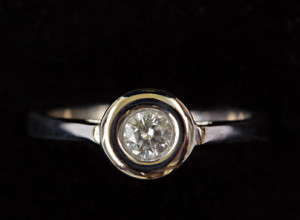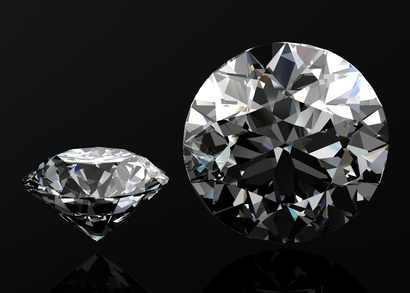Checking Your Ring for Loose Stones
So, how do you know if your gemstones are loose in their setting? A lot of people realize that something is wrong when they start hearing the stone rattle in the mounting. However, even if the problem is not so obvious, that doesn’t mean everything is fine.

One of the reasons stones loosen is that the ring’s prongs get worn down.
To test your ring, put your finger on the edge of the gemstone, and see if you can move or turn it lightly (be gentle so as not to loosen it further). The gemstone should be tight in the setting.
If you detect even a slight movement, you should have your ring checked and probably its stone tightened.
Is One of Your Diamonds or Gemstones Missing?
Very often, people don’t realize that one or more of their diamonds are missing from their ring. This is usually the case when there are a lot of small stones set in the mounting.
Pave-set stones are some of the easiest to fall off without being noticed. Invisible-set diamonds are also at risk as this type of setting does not hold stones as well as prongs do, for example.
Even channel settings, which are relatively secure, are not always safe: If the channel is damaged, it may not hold the stones well.
Why Diamonds and Gemstones Fall Out of Rings
Most commonly, diamonds fall out of their mountings when people hit their rings inadvertently. Some settings are not as sturdy as others, and a stronger bump can knock a stone out of its mounting.
Even if your setting is designed to be relatively secure, as is the case with prong and bezel settings, you are not 100% protected. With time, metal wears down, and mounting parts become less durable.
For example, if the prongs on your ring are too worn, they can bend, loosening your stone, and it may fall off next time you hit your ring.
Which Diamonds and Gemstones Are at Risk?
Diamonds set in prongs that are worn, bent or broken are at a high risk of loosening and falling out. If your setting is made of a softer metal such as gold or silver, you should be aware that its prongs are easy to bend and damage.
As already mentioned, diamonds set in invisible settings, pave settings, or settings with inlaid stones are also more prone to fall off.
Related: If you’re looking for a diamond ring, check out this selection of ring settings.
Reasons for Loose Stones
One of the most common reasons stones loosen is that the prongs holding them get worn down. With time, they become thinner and their heads get flatter, holding your gemstones less and less tightly.
This problem is seen more often in prongs made of softer and less durable metals such as gold or silver, which wear down more quickly.
When your prongs get thin from wear, they can easily break and your stone may fall off.
So, if your gemstone is loose and you have a prong setting, check if the prongs are thin and if their ends have become flat. If that is the case, remove your ring immediately, and take it to a jeweler to get it fixed.
Related: Check out these diamond rings that come with prong or bezel settings.
Very often, prongs also bend and their grip on your stone loosens.
Every time you hit or bump your ring, or when it gets caught on your clothing, your prongs are at risk of deforming. If one or more of them do get twisted, you will be able to see them – the problematic prongs are usually slightly raised above the stone.
When prongs are bent, they also catch on your clothes more easily. So, if your ring starts to snag your blouse more often, check whether its prongs are bent and see if the stones are loose.
You shouldn’t wear rings with problematic prongs, so take off your ring before the problem gets worse.
Fixing Loose Gemstones and Diamonds
Whenever you detect any loose stones in your rings, take them to a jeweler to get them fixed. How much the repair will cost depends on what is causing the problem.
If your prongs are bent, then fixing them is pretty straightforward. The jeweler will move them back in place and make sure the stone is held tight in the setting.
If your prongs are worn down, then they will most likely have to be rebuilt – partially or fully. This will cost you more than the rate for fixing bent prongs, and the price will depend on how worn the prongs are and what metal they are made of.
Sometimes, if your prongs are in really bad condition, the entire mounting may need to be replaced.
Have Your Rings Inspected Often
It is always better to detect any problems early, before your prongs break and your stones fall out.
That’s why you should have your rings checked regularly. And whatever the cost of the repairs, it often pales in comparison with how much your stone is worth, especially if it is a diamond.
So, how often should you have your rings inspected?
This depends on how often you wear them. A good rule of thumb is to have your rings checked a couple of times a year.
However, for pieces that you wear every day, you might want to do that more often – every three months or so. Nothing is stopping you from checking your ring yourself once every few days, though.
Settings Without Prongs
If you lead an active lifestyle and need a ring that has a more robust construction, consider getting a piece in which the gemstones are set without prongs.

Bezel settings are among the safest choices for diamonds.
For example, a bezel setting is a good option – it encircles your stone in a band of metal and makes it harder for the gemstone to get loose.
Not all prongless settings are safer, though. The so-called “invisible setting” doesn’t have any prongs but is actually more prone to loosening than prong settings.
Make sure the non-prong setting you are considering holds your stones more securely than prongs would.
How to Protect Your Gemstones and Diamonds
To make sure your stones are safe, have your ring fixed immediately if you find out that your stones are loose.
If you have a prong setting, be on the lookout for worn prongs. You should check regularly to see if any of the prongs are bent or broken – especially after you’ve hit your ring – and have them fixed if you spot any damage.
Be extra careful if your prongs are made of yellow gold, which is not very durable, and buy rings with white gold or platinum prongs if possible.
If you have a ring with invisible-set diamonds, do not wear it when doing any vigorous activity as shaking the ring hard may cause some of the stones to pop out of the mounting.
The same goes for rings with inlaid gemstones, which can easily fall off, especially if the glue holding them has gotten old and weak.
Be sure to clean your ring often as dirt can not only prevent you from spotting any damage to the setting but also make your ring’s parts wear down faster.
However, be careful with ultrasonic cleaners: The vibrations they produce tend to loosen stones, so check whether your settings are tight before and after you put your rings in these devices.














